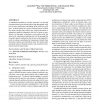Free Online Productivity Tools
i2Speak
i2Symbol
i2OCR
iTex2Img
iWeb2Print
iWeb2Shot
i2Type
iPdf2Split
iPdf2Merge
i2Bopomofo
i2Arabic
i2Style
i2Image
i2PDF
iLatex2Rtf
Sci2ools
SIGCOMM
2012
ACM
2012
ACM
Spinal codes
A fundamental problem in wireless networks is to develop communication protocols that achieve high throughput in the face of noise, interference, and fading, all of which vary with time. An ideal solution is a rateless wireless system, in which the sender encodes data without any explicit estimation or adaptation, implicitly adapting to the level of noise or interference. In this paper, we present a novel rateless code, the spinal code, which uses a hash function over the message bits to produce pseudo-random bits that in turn can be mapped directly to a dense constellation for transmission. Results from theoretical analysis and simulations show that spinal codes essentially achieve Shannon capacity, and out-perform bestknown fixed rate block codes. CATEGORIES AND SUBJECT DESCRIPTORS C.2.1 [Network Architecture and Design]: Wireless communication GENERAL TERMS Algorithms, Design, Performance KEYWORDS Wireless, rateless, channel code, capacity, practical decoder
| Added | 27 Sep 2012 |
| Updated | 27 Sep 2012 |
| Type | Journal |
| Year | 2012 |
| Where | SIGCOMM |
| Authors | Jonathan Perry, Peter Iannucci, Kermin Fleming, Hari Balakrishnan, Devavrat Shah |
Comments (0)

